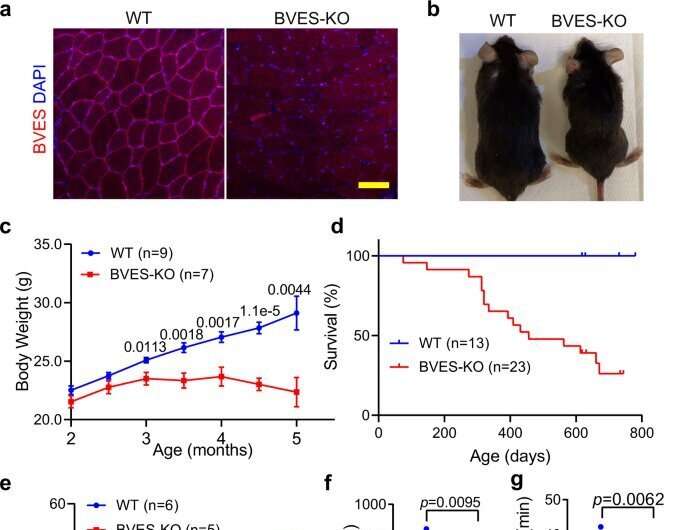This article has been reviewed according to Science X's editorial process and policies. Editors have highlighted the following attributes while ensuring the content's credibility:
fact-checked
peer-reviewed publication
trusted source
proofread
Researchers investigate the protein BVES and its important role in muscular dystrophy

A study by Indiana University School of Medicine researchers sheds new light on the development and treatment of a rare form of muscular dystrophy. The study's findings were recently published in Nature Communications.
Muscular dystrophies are a group of muscle diseases caused by gene mutations. There are several major varieties, including limb-girdle muscular dystrophy. According to the Centers for Disease Control, about 2 in 100,000 people are affected by various subtypes of limb-girdle muscular dystrophy which can develop at any age.
"Being a relatively new form of muscular dystrophy, very little is known about the development of limb-girdle muscular dystrophy type 25 and there is no treatment available for patients," said Renzhi Han, Ph.D., professor of pediatrics at the Herman B Wells Center for Pediatric Research and the senior author of the article. "Our study's main goal was to understand the molecular pathogenesis of muscular dystrophy caused by genetic mutations in BVES and develop a therapeutic treatment for this form of the disease."
The study investigated the role of blood vessel epicardial substance (BVES) protein in the development of muscular dystrophy and atrophy. The researchers found that the study's model engineered to lack BVES showed symptoms similar to those observed in humans. Further investigation showed that BVES interacts with an enzyme called ADCY9, inhibiting its activity in synthesizing cyclic AMP, an important signaling molecule in many biological processes.
The study also found the absence of BVES resulted in overactive ubiquitin proteasome degradation. Importantly, bortezomib, a specific inhibitor of ubiquitin proteasome degradation approved by the United States Food and Drug Administration for the treatment of certain cancers, significantly ameliorates the pathology of BVES-knockout skeletal muscle. Overall, these findings suggest that BVES may play a crucial role in maintaining muscle health and pharmacological treatments inhibiting proteasome degradation may be effective in alleviating BVES-deficient muscular dystrophy.
"Understanding the underlying causes of muscular dystrophy gets us one step closer to finding cures for patients," said Haiwen Li, Ph.D., postdoctoral fellow and co-author of the published study. "Our research sheds new light on therapeutic treatment options for patients with BVES mutations and it will lead to additional important investigations to help other diseases."
In addition to muscular dystrophy, BVES mutations are also linked to cardiac arrhythmia and cancer. Looking ahead, the researchers plan to investigate the roles of gene mutations in other health issues. They previously performed a preclinical study that demonstrated adeno-associated virus-BVES can improve muscle pathology and function in a mouse model with limb-girdle muscular dystrophy type 25. Results from that research were published in Molecular Therapy.
More information: Haiwen Li et al, Defective BVES-mediated feedback control of cAMP in muscular dystrophy, Nature Communications (2023). DOI: 10.1038/s41467-023-37496-8




















